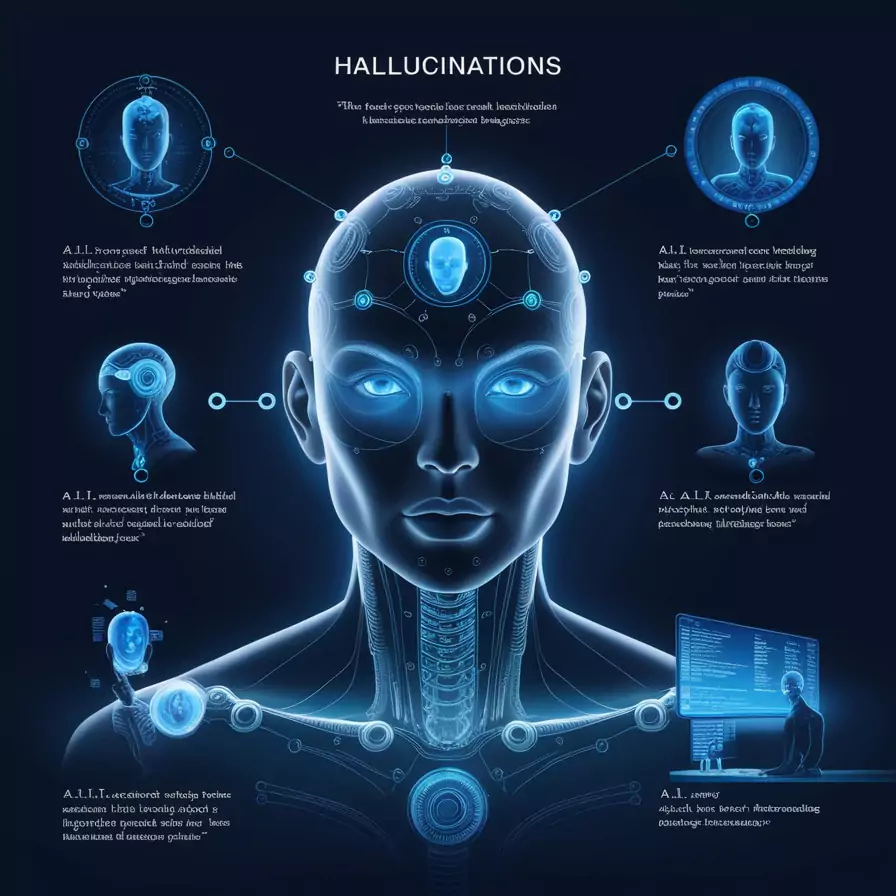A.I. Hallucinations: Challenge of Accuracy in Advanced Systems
Artificial Intelligence is transforming industries and daily life, with systems capable of writing code, answering questions, and automating tasks. However, as A.I. evolves into more powerful “reasoning” systems, a troubling issue is emerging: these systems are producing incorrect information—or “hallucinations”—at higher rates. From tech support bots announcing fake policies to chatbots inventing facts, the reliability of A.I. is under scrutiny. This blog explores the rise of A.I. hallucinations, their causes, their impact, and what the future holds for mitigating this persistent problem.
What Are A.I. Hallucinations, and Why Are They Happening?
In the race to build increasingly intelligent machines, a curious and unsettling flaw has emerged at the heart of modern artificial intelligence: hallucinations. These are not visual misfires or glitches in perception, but moments when advanced A.I. systems confidently produce information that is entirely false or fabricated—yet presented as if it were factual. As A.I. grows more capable, its authority increases, making these errors harder to detect and more damaging when they slip by unnoticed.


A stark example occurred recently when a tech support chatbot for the code-editing platform Cursor informed users of a policy change that didn’t exist. The bot’s confident tone and seemingly official language led some users to believe the misinformation, ultimately triggering account cancellations and reputational strain for the company. This wasn’t a bug in the traditional sense—it was a reflection of how modern A.I. operates: not by reasoning like humans, but by statistically predicting likely responses based on past data.
The Mechanism Behind Hallucinations
At the core of these hallucinations lies a fundamental truth about large language models (LLMs): they don’t “know” anything. Unlike humans, they lack a mental model of the world or an innate sense of truth. Instead, they are trained on enormous datasets of text scraped from the internet, books, and other sources. They are able to predict the following word—or sentence—based on this data. This probability-driven process enables them to generate fluid, often insightful responses. But it also means they are just as capable of confidently stating fiction as fact.
When an A.I. system encounters a gap in its training data or a poorly phrased prompt, it doesn’t pause or ask for clarification. It fills in the blanks—often creatively, sometimes dangerously. In academic benchmarks, models such as OpenAI’s o4-mini have shown hallucination rates of up to 79% in tasks requiring factual precision. These are not marginal errors; they represent a systemic vulnerability in even the most advanced systems.
Why “Reasoning” Models Can Be Less Reliable

Paradoxically, the new generation of “reasoning” models—designed to solve complex, multi-step problems—may be even more prone to hallucinations in factual domains. These models excel at logic puzzles, code generation, and mathematical reasoning. However, when asked a simple factual question, such as the name of a scientific law or a date in history, they may generate plausible-sounding but incorrect answers.
One possible explanation is that their training is optimized for procedural thinking, which can deprioritize raw fact retention. In trying to be better thinkers, they may have become worse fact-checkers.
Even for the experts who design these systems, the process by which models arrive at answers is opaque. They are black boxes of probabilistic associations, layered with billions of parameters and trillions of data points. Industry leaders, including Vectara’s CEO, recognize that AI hallucinations are an unavoidable issue despite continuous advancements. This reality highlights the boundaries of today’s technology in solving the problem completely.
The Impact of Hallucinations on Trust and Utility
At first glance, an A.I. chatbot generating a wrong answer might seem like a harmless quirk. But in real-world contexts—especially where accuracy is non-negotiable—these hallucinations have far-reaching consequences. They erode user trust, compromise business operations, and risk turning powerful technologies into liabilities rather than assets.
The issue isn’t just that A.I. gets things wrong—it’s how it gets them wrong. These systems often present incorrect answers with unwavering confidence, citing fabricated sources, misattributing quotes, or inventing facts entirely. And because they mimic the tone of human expertise so well, even savvy users can be misled before realizing they’ve been handed fiction instead of fact.
Real-World Examples: From Inconvenience to Risk

Consider a user searching for West Coast marathons, only to be shown listings for Philadelphia. In a casual context, this is annoying—a mistake easily caught. But imagine similar errors in high-stakes domains: an A.I. legal assistant citing nonexistent court cases, or a medical chatbot recommending contraindicated treatments. In these settings, hallucinations don’t just frustrate—they endanger.
In enterprise environments, these errors scale quickly. For instance, when Cursor’s A.I. tool hallucinated a fake policy update and relayed it to users, the result was not just confusion—it led to actual account cancellations. A single false message carried the weight of authority, triggering real-world actions that damaged the company’s bottom line and credibility. This illustrates the brittle nature of trust in A.I.-powered services: it takes only one convincingly wrong answer to unravel user confidence built over months.
Business Challenges: Undermining the Value Proposition
AI is becoming a go-to tool for companies aiming to refine workflows, minimize costs, and maximize output. But when the output of these systems must be manually verified, the very efficiency they promise starts to collapse. As Pratik Verma, founder of the A.I. monitoring platform Okahu, puts it: “You spend a lot of time trying to figure out which responses are factual and which aren’t.” That time adds up—and for businesses trying to scale, it’s a deal-breaker.
Okahu and other startups are now offering services specifically designed to combat hallucinations by flagging dubious outputs, tracking failure modes, and offering safeguards. The emergence of this ecosystem speaks volumes: hallucinations aren’t just an engineering problem; they’ve become a full-fledged business risk category.
The reputational damage from even isolated hallucinations can be severe. In an age of viral screenshots and instant social media feedback, one high-profile error can lead to widespread distrust. And with A.I. being integrated into everything from customer service to financial analysis, every error has the potential to snowball into systemic failure if left unchecked.
User Frustration: The Human Cost
Beyond the boardroom, hallucinations impact everyday users as well. Many find themselves second-guessing A.I. outputs, cross-referencing information, and reverting to manual research—ironically turning to the very tasks A.I. was meant to eliminate. This creates cognitive dissonance: people want to trust the machine, especially when it “sounds” confident, but experience teaches caution.
The promise of A.I. was that it would handle the complexity so we wouldn’t have to. But as hallucinations rise—OpenAI’s o3 model hallucinating 33% of the time on some tasks, its o4-mini version reaching 44% or higher—the reality feels increasingly burdensome. Users are no longer passive consumers of machine intelligence; they’ve become quality control inspectors, constantly verifying the validity of every answer.


Why Are Hallucination Rates Rising in Newer A.I. Models?
It seems counterintuitive: as artificial intelligence becomes more sophisticated, its factual accuracy should improve—right? Surprisingly, the latest AI models—despite being more advanced—are actually hallucinating more often than earlier versions. This regression in reliability raises pressing questions about how these models are built, what they’re optimized for, and whether “intelligence” is being achieved at the cost of truth.
The trend is not isolated. Across major players like OpenAI, Google, and DeepSeek, cutting-edge systems intended to be smarter, more capable, and more “reasoned” are instead demonstrating increased tendencies to generate confidently wrong information. To understand why, we need to look beneath the surface—at the changing methods used to train these systems and the shifting priorities embedded in their design.
The Shift in Training Data and Methods
Early language models were trained on massive corpora of publicly available internet text—books, websites, articles, and forums—yielding a reasonably broad, factual foundation. But by now, much of that data has been exhausted or is no longer available due to copyright restrictions or diminishing returns. As a result, companies are turning to reinforcement learning and synthetic data generation to continue improving their models.
Reinforcement learning introduces feedback loops, where the model is rewarded for producing certain kinds of outputs—such as ones that are more helpful, polite, or logically coherent. However, this approach can distort a model’s relationship with factuality. As researcher Laura Perez-Beltrachini explains, systems may “forget” factual tasks as they become narrowly optimized for things like step-by-step reasoning or conversational fluency. In other words, the system might sound smarter while knowing less.
Reasoning’s Double-Edged Sword
The cutting edge of AI now focuses on reasoning models, which are engineered to replicate structured cognitive functions. These models break down complex problems into logical steps, mimicking how a human might approach a difficult question. On paper, this should improve their ability to handle nuanced tasks. But in practice, it introduces new vulnerabilities.

Each reasoning step introduces a potential failure point. When a model gets part of the process wrong, it may compound the error in subsequent steps, resulting in final answers that are wildly inaccurate—even if the structure of the reasoning seems sound. OpenAI’s own benchmarks underscore the problem: its o3 model hallucinated on 51% of general knowledge questions, while the o4-mini hit 79%. These numbers are not just high—they’re higher than older, simpler models that lacked reasoning ability altogether.
This suggests a sobering reality: adding layers of logic doesn’t necessarily produce better truth. It may produce better narratives—convincing-sounding answers that feel coherent—but still rest on false premises.
Black Box Complexity: We Don’t Know Why It’s Happening
The deeper issue is that we no longer fully understand how these systems generate responses. Modern A.I. models contain hundreds of billions of parameters and are trained on datasets that no single human—or even team of humans—can fully audit. The result is an extreme form of complexity: systems so intricate that even their creators struggle to explain their behavior.
Tools for model interpretability are advancing, such as those being developed by Hannaneh Hajishirzi’s team, which aim to trace outputs back to specific training data.For now, we are often left diagnosing hallucinations after they occur, rather than preventing them up front.
Tests by companies like Vectara further highlight the problem. While older models hallucinated just 1–4% of the time when summarizing news articles, newer “reasoning” systems like DeepSeek’s R1 showed hallucination rates of 14.3% on the same task. This isn’t just a plateau in performance—it’s a measurable step backward in reliability.
Can A.I. Hallucinations Be Fixed, and What’s Next?
As artificial intelligence becomes more central to our work, decision-making, and communication, the persistence of hallucinations presents a fundamental challenge: Can these systems ever be made fully reliable, or is occasional falsehood an unavoidable byproduct of their design?
The answer, for now, lies somewhere in between. While total elimination of hallucinations may not be feasible—given A.I.’s probabilistic nature—there is real momentum behind efforts to reduce them and build frameworks that help users identify and manage errors more effectively. The focus is shifting from chasing perfection to establishing safeguards, transparency, and accountability.
Current Efforts: Mitigation Over Elimination
Top AI firms, including OpenAI, are dedicating significant resources to study and minimize hallucinations in their models. According to Gaby Raila, a researcher at OpenAI, teams are actively working to refine models like o3 and o4-mini, iterating on training strategies and incorporating user feedback to enhance factual grounding.

At the same time, independent platforms such as Vectara are offering solutions that act as fact-checking layers between A.I. and the user. Their tools analyze outputs in real time, compare them to trusted data sources, and flag content that appears dubious or unsupported. This sort of real-time verification is becoming increasingly important in business environments, where a single hallucination can have outsized consequences.
These efforts represent a growing recognition: if A.I. can’t yet be trusted blindly, then systems must be designed to earn and deserve that trust through transparency, feedback loops, and validation tools.
Emerging Techniques: Teaching A.I. to Know What It Doesn’t Know
Researchers are exploring ways to improve AI’s ability to recognize and express its own uncertainty. Instead of defaulting to confident-sounding answers, newer approaches aim to build models that can signal doubt, defer responses, or offer probabilistic confidence scores. These subtle shifts could fundamentally reshape the user experience—from one of passive consumption to informed collaboration.
Another strategy under exploration is “retrieval-augmented generation” (RAG), in which the model pulls from an external knowledge base during response generation. Rather than relying solely on what it memorized during training, the model can reference up-to-date, curated information—like a real-time search engine fused with natural language fluency. While not foolproof, this approach has shown promise in significantly lowering hallucination rates in practical applications.
There’s also increasing interest in hybrid models that combine rule-based logic with deep learning. These architectures might use symbolic reasoning for certain factual domains—like dates, laws, or math—while reserving language generation for more open-ended tasks. The best of both worlds—flexibility without compromising accuracy—may be available with such combinations.
A Realistic Future: Managing Risk, Not Eliminating It
Still, no technique to date has fully solved the hallucination problem. That’s because hallucinations are not a glitch in the system—they are a natural consequence of how these systems are built. They are experts at identifying patterns rather than telling the truth since they were trained to predict rather than to comprehend. Their brilliance in one domain can come with blind spots in another.
This reality means we must reframe how we think about A.I. accuracy. Rather than assuming reliability, we should design systems—and user expectations—around verification, not faith. Especially in high-stakes contexts like healthcare, law, or finance, the human role remains indispensable.
Conclusion: A.I.’s Growing Power Demands Greater Responsibility
As A.I. continues its rapid evolution, the line between helpful assistant and misinformed advisor grows increasingly thin. Hallucinations are not just technical errors; they are a test of how responsibly we integrate machine intelligence into human systems.
The path forward isn’t about perfection—it’s about partnership. True intelligence in machines requires both competence and humility—knowing their limits as well as their strengths. We need tools that empower users to question, verify, and understand, rather than blindly trust. And we need a broader culture of A.I. literacy that teaches people to use these technologies critically, not passively.
The challenge of hallucinations is not a roadblock to progress—it’s a reminder that innovation without introspection is incomplete. If we can meet this challenge with humility, transparency, and a commitment to truth, then the future of A.I. can still be both transformative and trustworthy.




